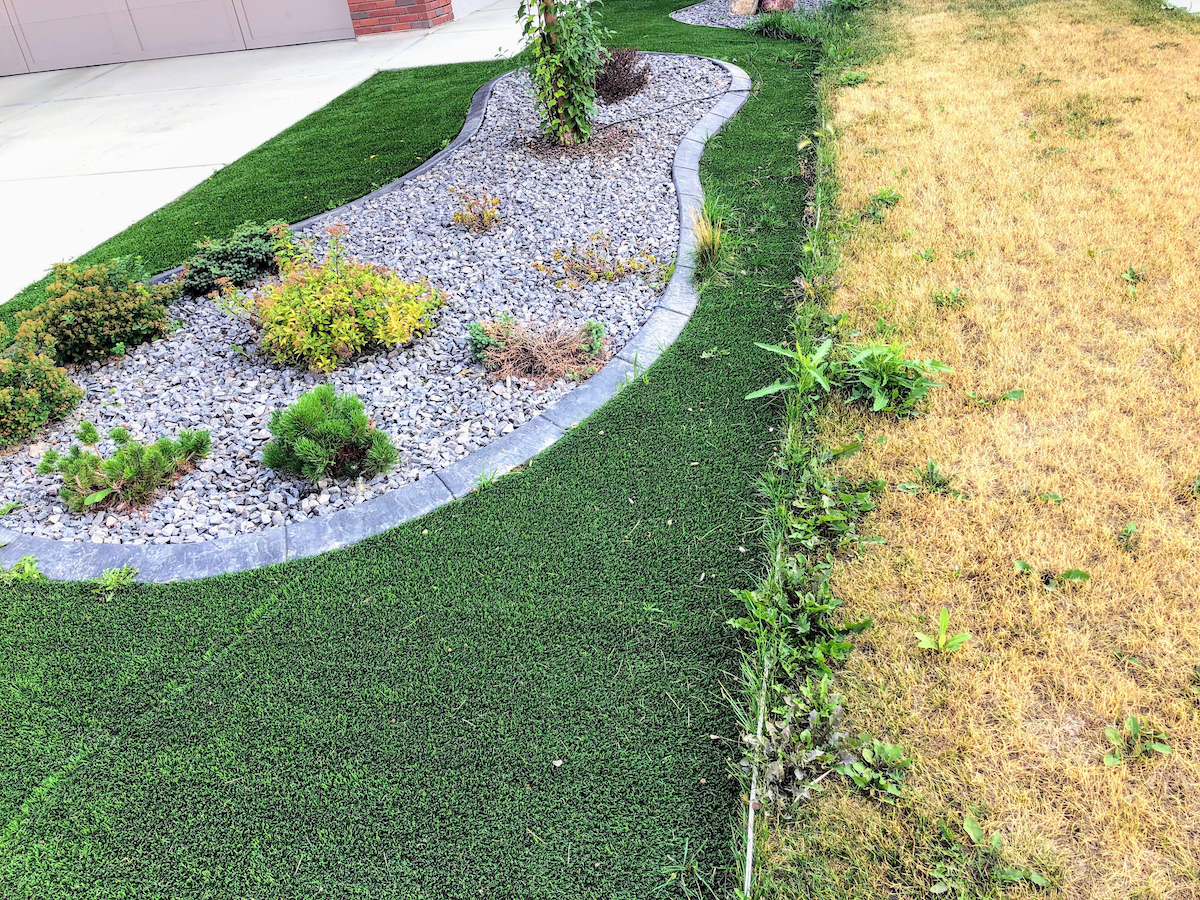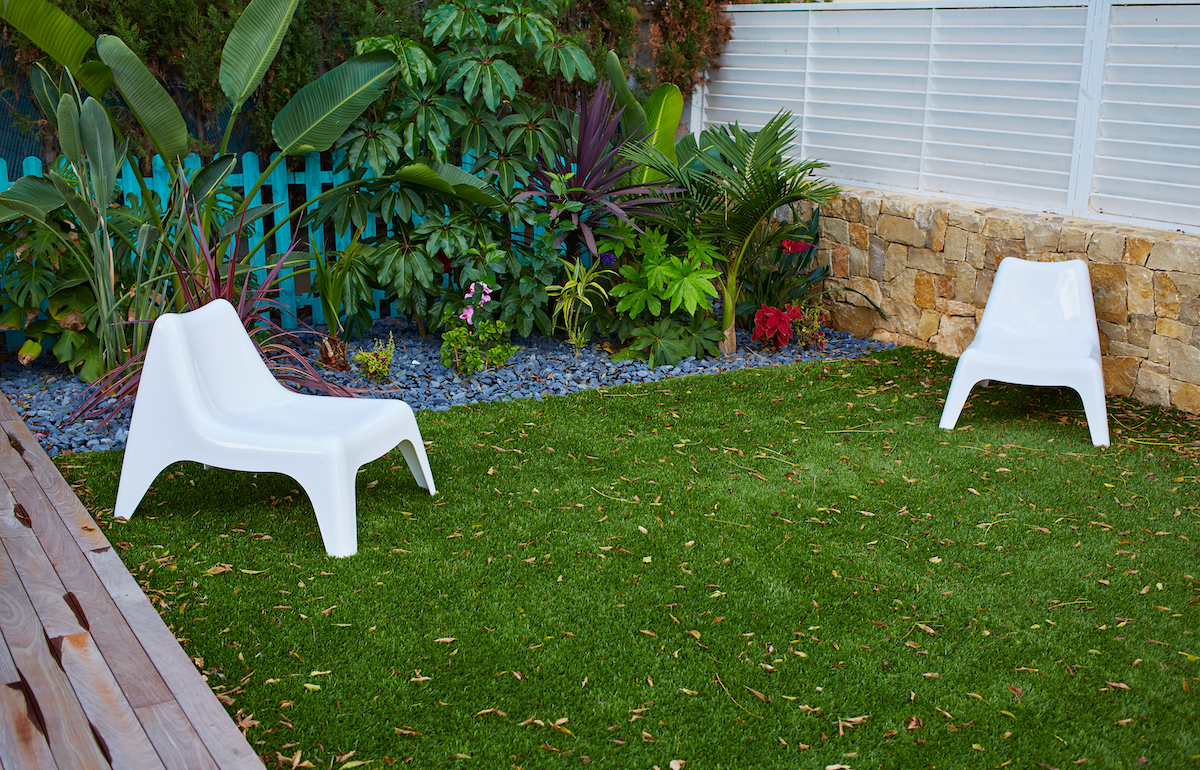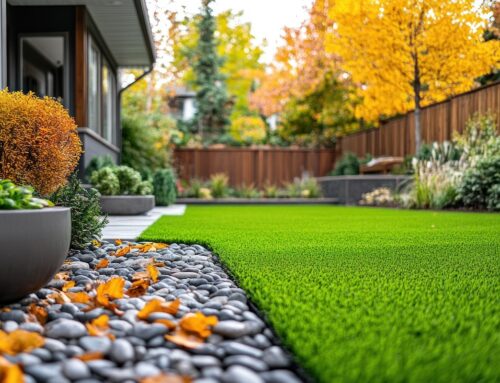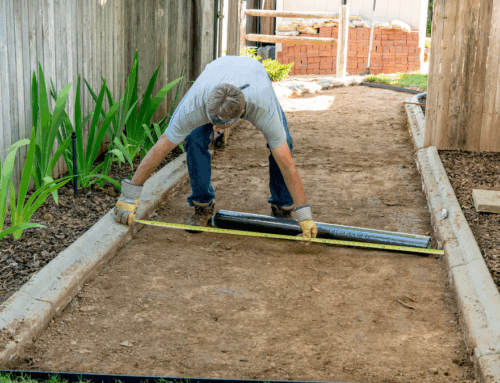Last Updated on March 24, 2025 by ReTurf
Artificial turf has become a popular landscaping choice due to its durability and low maintenance. It provides a consistently green appearance year-round without the need for watering, mowing, or fertilizing. While artificial turf offers convenience, many property owners want to integrate live plants into their synthetic landscapes to add natural beauty, provide shade, and support local ecosystems.
Planting trees and other vegetation in artificial turf presents challenges. The compacted base beneath synthetic grass restricts root growth, and artificial turf does not retain moisture the way natural soil does. However, with proper planning, live plants can successfully be incorporated into artificial landscapes without compromising the integrity of the turf.
Why People Choose to Plant Trees and Natural Plants in Artificial Turf
Artificial turf provides a uniform and tidy appearance, but it lacks the benefits of real plants. People choose to add trees and vegetation for several reasons.
Temperature Control and Shade
Artificial turf retains heat, making it significantly hotter than natural grass, especially in direct sunlight. This can make outdoor areas uncomfortable and increase surrounding temperatures. Trees and shrubs provide natural cooling by blocking sunlight and releasing moisture into the air. Shaded areas are more comfortable to walk on, reducing the heat-related drawbacks of artificial turf.

Aesthetic Variety
A landscape made entirely of artificial turf can sometimes look too uniform or unnatural. Integrating trees, shrubs, and flowers adds height, color, and texture, making the space more visually appealing. Seasonal changes in foliage and blooms create variety throughout the year.
Environmental Benefits
Artificial turf does not contribute to air purification or biodiversity the way live plants do. Trees and shrubs produce oxygen, absorb carbon dioxide, and filter pollutants from the air. Plants also provide shelter and food for birds, pollinators, and other wildlife that would not otherwise be present in an artificial turf environment. Used artificial grass is an alternative to consider when you may want to reduce your footprint without having to water a lawn. This is especial important in draught prone areas.
Property Value
Landscaping plays a significant role in curb appeal and property value. A well-maintained landscape that integrates both artificial turf and live plants often appears more inviting than a purely synthetic one. Buyers and renters tend to favor properties with trees and greenery over those that rely solely on artificial materials.
Challenges of Planting in Artificial Turf
Although the benefits of adding live plants to artificial turf are clear, there are several challenges that must be addressed for successful integration.
Limited Soil Access
Artificial turf is installed over a compacted base that provides stability and drainage, but this layer also restricts plant roots from accessing natural soil. Without modifications, roots cannot spread properly, leading to poor growth or plant failure.
Drainage Considerations
Artificial turf is designed to allow water to pass through its surface and drain into the base layer below. However, this system does not provide the necessary moisture retention for tree and plant roots. If the planted area is not prepared correctly, water may either drain too quickly, preventing plants from absorbing enough moisture, or pool in certain areas, leading to root rot.
Root Interference
Tree roots spread as they grow, and some species have aggressive root systems that can lift or displace artificial turf over time. This can create uneven surfaces and require repairs. The best way to prevent this is by choosing trees with less invasive roots and installing root barriers to direct growth downward instead of outward.
Increased Maintenance
One of the main advantages of artificial turf is its low-maintenance nature, but adding live plants changes that. Trees and shrubs require watering, pruning, and regular leaf removal to prevent organic debris from accumulating on the synthetic surface. Without proper upkeep, leaves, twigs, and plant debris can create a mess and lead to weed growth.
Fire Hazards
Some plants and trees shed dry leaves or bark that can be flammable, especially in hot or arid climates. Artificial turf is generally fire-resistant, but accumulated plant debris increases fire risks. Selecting fire-resistant plants and maintaining a clean landscape helps reduce potential hazards.

Legal and HOA Considerations
Before adding trees or plants to an artificial turf landscape, it is important to check for any restrictions or regulations. Some areas have limitations on whether artificial turf itself is allowed, which can affect what modifications are permitted.
- Some homeowner associations have strict landscaping guidelines that limit modifications to artificial turf installations.
- Local ordinances may require permits for tree planting, especially near sidewalks, underground utilities, or property lines.
- Certain drought-prone areas enforce water conservation rules that affect plant selection and irrigation methods.
- Some municipalities restrict where artificial turf can be installed, particularly in front yards or visible areas.
Failure to comply with these regulations could result in fines or the need to remove improperly placed plants. Researching local requirements before planting helps avoid potential issues.
Choosing the Right Trees and Plants
Selecting the right plant species is essential to prevent problems such as excessive maintenance, invasive roots, or poor adaptation to artificial turf conditions. The best trees and plants for artificial turf landscapes are those that require minimal water, have controlled root systems, and do not shed excessive debris.
Trees That Work Well with Artificial Turf
- Eastern redbud
- Desert willow
- Southern magnolia
- Live oak (in larger spaces)
These trees are native to various regions, offering shade and visual appeal while maintaining non-invasive root systems that won’t disrupt artificial turf. They also require less irrigation than non-native species, making them a sustainable choice.
Shrubs and Bushes That Fit Well with Artificial Turf
- Wax myrtle
- Yaupon holly
- Coastal sagebrush
- Buttonbush
Native shrubs are adapted to local climates and soil conditions, making them more resilient and lower maintenance. They provide year-round greenery and support pollinators and local wildlife without requiring frequent trimming.

Flowers and Ground Cover Plants That Thrive in Artificial Turf Landscapes
- Black-eyed Susan
- Blanket flower
- Creeping phlox
- Wild bergamot
These flowering plants are naturally drought-tolerant, adding color to the landscape while attracting bees, butterflies, and other beneficial pollinators. Their deep-rooting nature allows them to thrive with minimal irrigation.
Plants to Avoid
Willows, ficus, and poplars should be avoided due to their aggressive root systems, which can disrupt artificial turf stability. Trees that produce excessive sap, fruit, or leaf litter can also increase maintenance requirements, making them impractical for artificial landscapes.
How to Successfully Plant in Artificial Turf
To ensure trees and plants thrive in an artificial turf landscape, proper preparation is essential.
- Mark the Planting Areas – Identify where trees and plants will go, ensuring proper spacing.
- Cut and Remove the Turf – Using a utility knife, carefully cut an opening in the artificial turf where each plant will be placed.
- Excavate the Soil – Remove the base layer beneath the turf to create enough space for roots to grow.
- Amend the Soil – Replace the removed material with nutrient-rich soil to support plant health.
- Install a Root Barrier – If planting trees, place a root barrier around the perimeter to prevent roots from spreading beneath the turf.
- Set Up Irrigation – Use drip irrigation or soaker hoses to provide consistent water directly to plant roots.
- Secure the Turf Edges – Once planting is complete, secure the edges of the artificial turf to maintain a clean appearance.
- Add Mulch or Gravel – Around trees and shrubs, apply mulch or decorative gravel to help retain moisture and suppress weeds.
Properly following these steps ensures that plants establish strong root systems without compromising the artificial turf installation.
Maintenance and Long-Term Considerations
Adding live plants to artificial turf introduces ongoing maintenance requirements.
- Watering – Trees and shrubs need regular irrigation, especially in hot climates.
- Pruning and Trimming – Keeping plants well-maintained prevents overgrowth and reduces debris accumulation.
- Cleaning the Turf – Fallen leaves, twigs, and organic debris should be regularly cleared to maintain a neat appearance.
- Weed Prevention – Using landscape fabric or mulch around plant bases can help prevent weed growth.
A well-planned approach ensures that artificial turf remains clean while live plants thrive.

Alternative Ways to Incorporate Greenery Without Planting in Artificial Turf
For those who want the benefits of live plants without cutting into artificial turf, other options include:
- Raised planters – Placing trees and shrubs in decorative containers or raised beds.
- Landscaping borders – Surrounding artificial turf with natural planting areas.
- Vertical gardens – Using green walls or trellises to introduce natural elements without modifying the ground.
These alternatives allow for the integration of greenery while preserving the integrity of the artificial turf installation.
Environmental Impact and Sustainability Considerations
Artificial turf is often marketed as an eco-friendly alternative to natural grass, primarily because it reduces water usage and eliminates the need for fertilizers or pesticides. However, introducing live plants into artificial turf landscapes changes the environmental equation.
One of the biggest concerns is soil health. When artificial turf is installed, the underlying soil is often compacted, covered with a base layer of crushed rock, and separated from the surface by a weed barrier. Over time, this setup can degrade the soil, reducing its ability to support plant life. Adding trees and plants helps restore some of these natural functions, but only if the planting areas are properly prepared. If too much of the area is covered in artificial turf with only small pockets of exposed soil, the long-term health of the landscape may still decline.
Another consideration is artificial turf’s impact on underground ecosystems. Natural lawns allow for earthworms, beneficial microbes, and fungi to thrive, all of which contribute to healthy soil. When artificial turf covers large portions of land, these ecosystems are significantly reduced. While planting trees and plants can help counteract some of this loss, it does not fully replace the biodiversity that natural grass and native ground cover provide.
Water runoff is also a factor. While artificial turf is designed to drain efficiently, it does not absorb water the way soil does. This means that areas surrounding planted trees and shrubs may receive more concentrated runoff, potentially leading to erosion or oversaturation. Installing proper drainage solutions, such as permeable borders or gravel beds, can help manage water distribution more effectively.
Comparing Maintenance and Costs of Different Landscape Types
Each type of landscape requires a different level of maintenance. Fully artificial yards demand the least upkeep, while fully natural landscapes require the most. Mixed landscapes that combine artificial turf with live plants fall somewhere in between.
Fully Artificial Turf
- Watering: None
- Pruning & Trimming: Not required
- Weed Control: Minimal, occasional spot treatment
- Cleaning & Debris Removal: Periodic sweeping or rinsing to remove dust and dirt
- Overall Maintenance: Low
Artificial Turf with Plants
- Watering: Only for planted areas; regular irrigation needed
- Pruning & Trimming: Necessary for trees and shrubs to prevent overgrowth
- Weed Control: Some weed prevention required around planting zones
- Cleaning & Debris Removal: Frequent clearing of leaves, fallen petals, and organic debris
- Overall Maintenance: Moderate
Fully Natural Grass and Plants
- Watering: Regular irrigation required for both lawn and plants
- Pruning & Trimming: Ongoing mowing, hedge trimming, and seasonal pruning
- Weed Control: Requires herbicides or manual weeding to maintain appearance
- Cleaning & Debris Removal: Constant upkeep needed for grass clippings, leaves, and plant waste
- Overall Maintenance: High

Long-Term Planning for Artificial Turf and Natural Plants
When incorporating live plants into artificial turf, long-term planning is essential. Mistakes made during installation can lead to costly repairs or premature plant failure. To avoid future issues, consider the following factors.
Selecting Trees That Will Not Outgrow the Space
Some tree species are more manageable than others in artificial turf environments. Avoid trees that grow too large, shed excessive leaves, or have aggressive root systems. Trees that remain compact and have controlled root growth are ideal.
Preparing for Soil Settling and Compaction
If trees are planted in artificial turf without proper soil preparation, settling may occur over time, causing the turf to become uneven. To prevent this, compacted soil should be loosened, amended with organic material, and given time to settle before artificial turf is secured around the planted area.
Factoring in Future Root Growth
Even trees with less aggressive root systems will expand over time. Installing root barriers helps prevent roots from growing outward under the artificial turf, minimizing the risk of surface buckling.
Alternative Ways to Add Greenery to Artificial Turf
For those who want the benefits of natural plants without cutting into artificial turf, several alternatives allow for a balance between synthetic and living elements.
- Raised garden beds – Trees and plants can be placed in decorative containers or raised beds positioned around artificial turf.
- Surrounding borders – Keeping trees and plants along the edges of artificial turf rather than embedding them within helps maintain turf stability.
- Living walls or vertical gardens – Instead of planting in the ground, vertical planters or trellises allow for greenery without disrupting artificial turf.
These methods allow for natural elements to be included in artificial landscapes while minimizing installation challenges and maintenance concerns.



